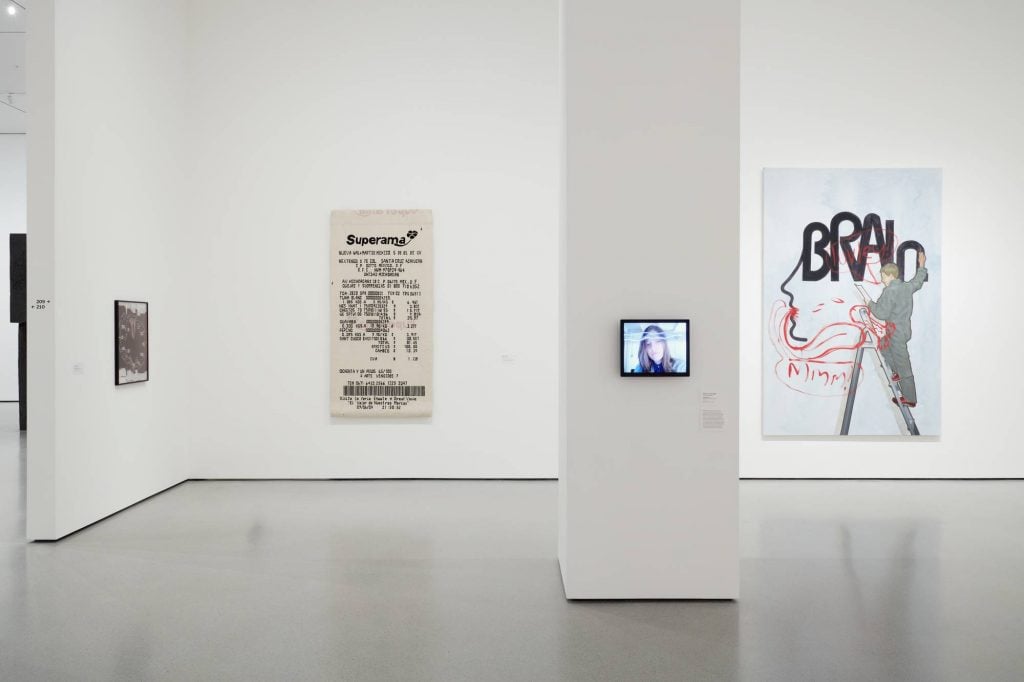Articolo su ArtNet autore Brian Boucher, November 17, 202
For much of the Museum of Modern Art’s history, the story of art has remained static, with collection galleries left unchanged for years at a time. But when the museum reopened last year in an expanded building it pledged to refresh its collection galleries twice a year, deploying its millions of objects to tell new stories, and forge a new future.
The museum also aimed to move into a new era in which distinctions between high and low and between artistic mediums have eroded. Whereas the old MoMA typically segregated works by medium, new MoMA displays paintings, sculpture, photography, and film together. And whereas the old MoMA told a Western-centric tale of art history, focused on a Paris-New York axis, it now aims to broaden its geographical purview and introduce lesser-known names. (Reviewing the museum’s reinstallation a year ago, Artnet News critic Ben Davis found that the battleship wasn’t so easy to quickly steer in a new direction in this regard.)
This fall, as museum administrators anxiously watch virus case numbers and hope to remain open, MoMA has reinstalled a full third of its 60 collection galleries on the second, fourth, and fifth floors. Some of the new displays include Gerhard Richter’s 15-painting cycle devoted to the Red Army Faction; a room-size photo-and-text installation by Carrie Mae Weems; an investigation of the representation of crime in photography, organized around a recent Gordon Parks acquisition; and a gallery devoted to the social issues of the 1980s, in which a video installation by British-Ethiopian Theo Eshetu towers over works by better-known artists such as Glenn Ligon, Adrian Piper, and Kiki Smith. (New York Times art critic Roberta Smith surveyed the new installation and found that it “bodes extraordinarily well.”)
Emblematic of the museum’s endeavor overall is gallery 209, a mini-exhibition titled “Search Engines” on the second floor, which houses art from 1970 to the present. Including works from the first two decades of the new millennium, it focuses on the historic 1998 launch of Google. It studies the way that artists have responded to the internet’s penetration into every aspect of our lives, not only with new-media works like Petra Cortright’s VVEBCAM (2007), which was created for YouTube and is on view at the museum for the first time, but also with handcrafted pieces that react to our new reality, such as Gabriel Kuri’s 2005 piece Untitled (Superama II), a woven, wall-hung work that reproduces a receipt from a Mexican department store.
“I was asked to imagine a gallery that would represent art around the turn of the millennium, and there were a couple of works that were first and foremost in my mind, that demonstrated key ways that artists have thought through the Internet and how search engines have impacted our everyday lives,” said Lanka Tattersall, who curated the gallery. “There was Seth Price’s Essay with Knots [2008], and then a group of unexpected prints by Wangechi Mutu, Eve, which have never been on view at the museum before, that are thinking through the female archetype.”
The museum’s desire to take a more global view is “hardwired into any question I might ask about contemporary practices,” said Tattersall. “I was thinking about the search engine as a global phenomenon. Gabriel Kuri’s piece Untitled (Superama II), which is a woven receipt from what is basically the Mexican Walmart, is to me a very modern portrait. It’s a disposable, small thing you put in your pocket that shows what you bought on any given day. But scan the bar code at the bottom and you’re connected to a network of information that can be a help and a hindrance. This piece touches on questions of globalization that feel really pressing.”
Stuart Comer, who oversaw the second floor’s reinstallation, pointed out that not only does “Search Engines” relate thematically to other galleries on the second floor, but it even links up vertically to the same space on upper floors, where historical figures like Marcel Duchamp, inventor of the Readymade, are on display.
“The Googleverse, where you have an endless stream of information at your fingertips,” added Lanka, “makes the whole world kind of a readymade.”

Installation view of the gallery Search Engines in the exhibition “Collection 1970s–Present.” The Museum of Modern Art, New York. Digital Image © 2020 MoMA, N.Y. Photo by Denis Doorly.

